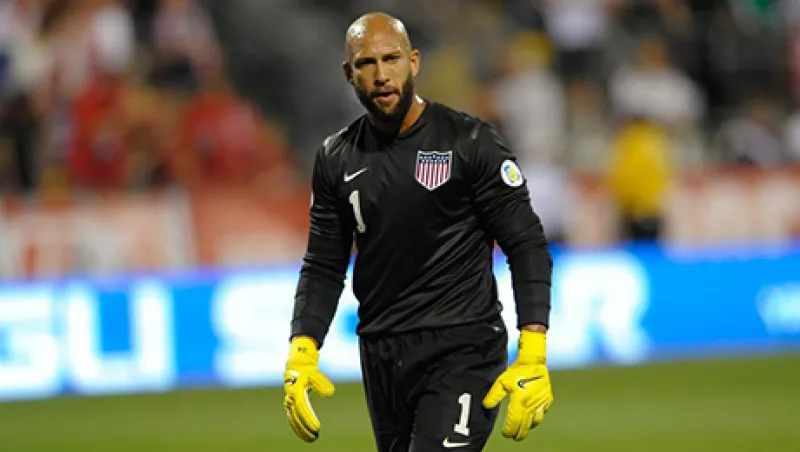In the match versus Belgium that knocked the U.S. out of the World Cup, American goalkeeper Tim Howard became an instant international sports phenomenon. His 16 saves set a tournament record; his performance was hailed as the best of his long career and perhaps the best of any goalie in the World Cup. But Howard was only the second goal box celebrity at this year’s World Cup. The first just wasn’t human.
Months before the opening match of the World Cup, a video apparatus called goal-line technology, or GLT, stirred up major controversy among commentators, officials and players. GLT monitors goals and reports to referees whether a goal has been scored; within a second, a signal is sent to watches worn by referees to let them know whether the ball crossed the goal line. The ball’s position is tracked either by video cameras, as in the case of GoalControl, the system in use at the World Cup, or by magnetic field technology.
I have written before about how technology is making its way into the world of sports like basketball and soccer. This doesn’t mean the end of the judgment call — that is, of the subjective art of observation and finesse exercised by human referees — but it signifies changes both for soccer and for the global culture of sport.
We are becoming more and more comfortable with tech and with extending our reliance on machines farther and farther into our lives — including mass activities like sports that often seem to embody our dreams and desires as human beings and whose social, public nature symbolizes and further encourages the acceptance of any given cultural trend. One thing GLT at the World Cup tells us is that the qualitative (the subjective) is vanishing from many quarters where it used to reign, and the quantitative (the objective or statistical) is beginning to take its place.
It’s worth noting that American sports are more affected by the hunt for the precision call than are those beloved by the rest of the world. Baseball leagues utilize video cameras to assist with strike and ball calls at the plate. American football has led the way in experimenting with immersive, virtual reality training and quant-based exercise and diet programs that monitor and quantify performance in new ways. And it was baseball, again, that introduced quantitative science, in this case statistics, to sports recruiting and managing (see Michael Lewis’s account in Moneyball).
By contrast, soccer — with the international league overseen by FIFA — is one of the world’s most subjective sports, with a large field, extremely rapid play and a complicated fouling system. Even the amount of time a match takes to play is up for debate. A soccer match is supposed to last exactly 90 minutes, with as few stoppages as humanly possible — and if time is wasted during play, referees can choose to add on several minutes more. (Even more strangely, a fourth, auxiliary referee helps determine the amount of wasted time and thus the number of minutes that should be added.) These kinds of decisions — and the ambiguity referees face — can both add drama and interest to the matches or draw down the ire of players and fans.
But it’s easy to imagine a soccer game in which offside calls are reinforced by video cameras that track the relative locations of all players on the field or in which the bounds of the field itself are policed so that a ball that might slip across by a centimeter would trigger a whistle to signal that it was out. This is frightening to many fans and bloggers, who insist that soccer’s passionate spirit would be damaged, or at least discouraged, by the presence of cameras or sensors — and that some of the magic of the game would be lost.
Those claims speak more about the temperament of the fans who make them, and perhaps aren’t worth much credence. GoalControl systems are basically invisible, and no one but the referees on the field receives any notification as to their verdict. There are other, better arguments against such technological advancements: As early as April of last year, the New York Times wrote that the case against GLT isn’t so much that soccer would be destroyed by computers but that computers aren’t available to everyone playing the game.
If FIFA required referees to reference or weigh information provided by GoalControl or a similar system to make all calls, the rules by which international soccer is currently played wouldn’t be usable. Still, there’s a certain appeal to the idea that all soccer players, regardless of age or nationality or class, would be abiding by the same code and would therefore be unified by it. Then again, a group of boys playing street soccer might deserve their own rules, appropriate for their environment and local culture of sport. Brazil, for instance, has its own famous style of playing — jogo bonito — which emphasizes grace and beauty and is taught to younger players who may not even have or want shoes to play in.
At their best, sports fascinate us because they give us visual pleasure while raising complicated questions about class, fairness and competition in our society. And even at a slightly less grand scale, GLT and similar technologies will be exciting for sports commentators to address over the next years — as they will be for the members of the tech world who build the devices that now take the field along with Argentina’s Lionel Messi and Germany’s Thomas Müller. Playing style would have to shift and evolve alongside technology like GLT. Would the disappearance of human referees and the removal of the margin of error to which they are subject alter the game itself? The answer is on the horizon, in the next World Cup and the next after that. And as surveillance technologies — sensor arrays, video cameras, drones — become ever cheaper, even the kids on the futbol pitches of the developing world might learn to play with a GoalControl watching.






